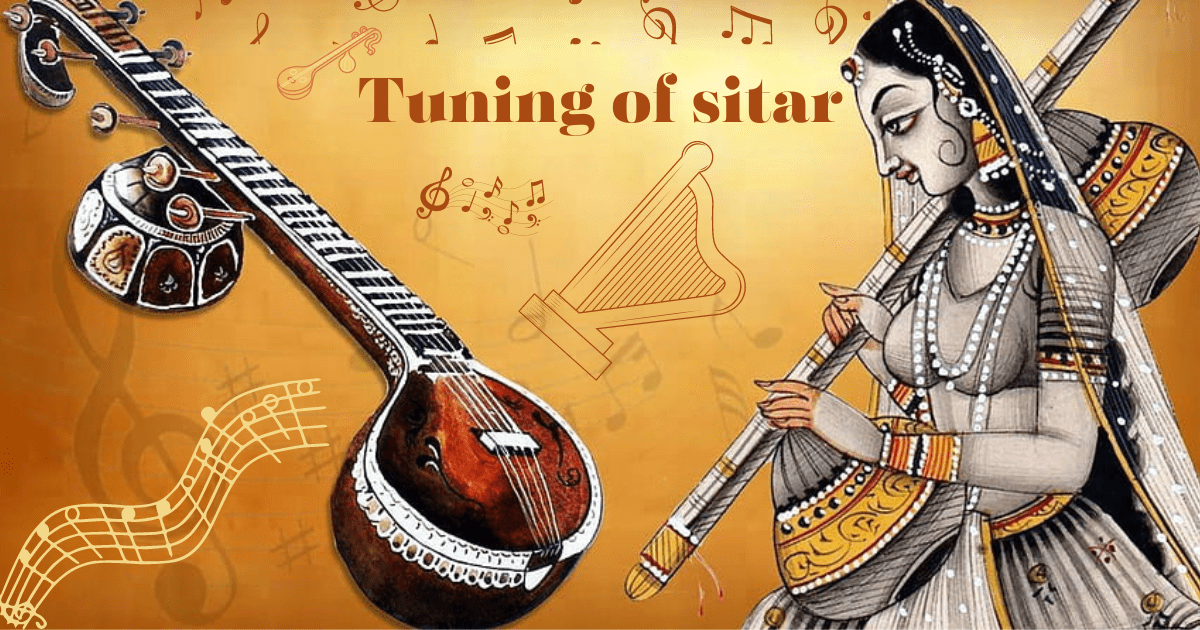...
Sitar Tuning: A Comprehensive Guide to Kharaj Pancham Tuning

Among the different instruments associated with Indian classical music, the sitar is always kept at the topmost position. It is an instrument associated with the goddess of music Ma Saraswati and is used by her to play melodies. It is divine and complex at the same time and hence tuning of sitar is an equal challenge. In this blog, we are going to understand how to tune a sitar perfectly.
Understanding Tuning
There are seven main strings and additional sympathetic strings present in a sitar. These strings are attached to the khoontis at the end of the dandi(long wooden surface). Unlike the common Western style tunings, tuning of sitar is a unique and complex process and is known as kharaj-pancham tuning.
Kharaj Pancham Tuning
Similar to most forms of music persisting in the world, Indian classical music also has 7 basic notes, and the seven main strings of the sitar are tuned into these 7 basic notes – sa re ga ma pa dha ni sa. This kind of tuning is known as the kharaj pancham tuning in the sitar. Different ragas use different combinations of notes. While playing a particular raaga, the strings of the sitar are to be tuned into the notes of that raaga. For example – Raag Bhairav has seven notes in it among which 5 are shuddha and two are komal. Re and dha are komal swaras and sa ga ma pa and ni are shudda swaras. While performing raag bhairav, the sitarist has to tune the sitar keeping re and dha komals and other swaras shuddha.
Process of Tuning
As the instrument is complex, so is its tuning. The person who is tuning the sitar is required to have a deep understanding of sound and variations. People often use tanpura to do the tuning of the sitar as they are able to match the sa pa and teevra sa of the sitar to the sounds of the tanpura. The tuner is required to tighten or loosen the pegs attached to the end of the neck. Tightening the pegs increase the pitch of the string and vice versa.
Strings of the Sitar
Sitar consists of two types of strings – mains strings and additional sympathetic strings. The main strings are made up of metals and are tuned into the 7 essential notes – sa re ga ma pa dha ni sa and the sympathetic strings resonate with the main strings increasing the sound quality of the main string and proving a divine effect to them.
Main Playing Strings of the Sitar
- Kharaj: it is the first and the thickest string of the sitar and gives base and depth to the instrument.
- Jor: it is the second thickest string and represents the second note of classical music.
- Laraj: this string is comparatively thinner than the jor and represents the third note of the Indian classical notes.
- Kharaj Pancham: it is the fourth thickest string of the sitar and decides the melodic range of the instrument.
- Gandhar: it is the fifth string of the sitar and gives a balanced sound of pitch when played.
- Nishad: this string is comparatively thinner than the kharaj pancham and adds more depth and melody to the instrument.
- Pancham: This is the thinnest string of the sitar and gives produces divine sound when played.
Additional Sources
- Information About The Strings Of Sitar | सितार के तार – Information About The Strings Of Sitar | सितार के तार
- Sitar (19 strings that aren’t as complicated as they seem… well maybe.) –Sitar (19 strings that aren’t as complicated as they seem… well maybe.)
- Anoushka Shankar & Manu Delago with Metropole Orkest Strings – Live at Le Guess Who? – Anoushka Shankar & Manu Delago with Metropole Orkest Strings – Live at Le Guess Who?


